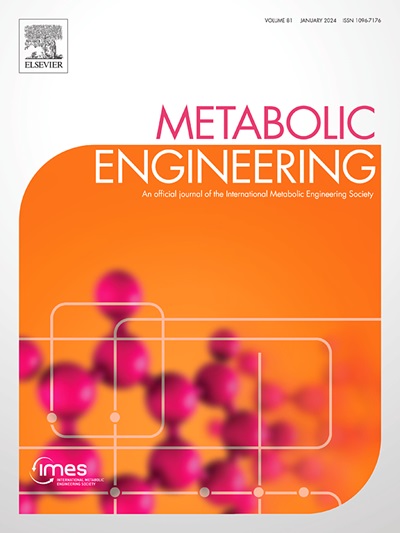大肠杆菌高效合成d -泛酸酯的杂交途径设计
IF 6.8
1区 生物学
Q1 BIOTECHNOLOGY & APPLIED MICROBIOLOGY
引用次数: 0
摘要
d -泛酸酯(D-PA)是辅酶a的重要前体,广泛应用于各个工业领域。传统的D-PA化学合成涉及有毒物质,包括氰化物,并产生环境污染。葡萄糖全生物合成仍存在反应时间长、效价低的局限性。为了提供一种新的途径,我们设计了一种混合途径。首先,我们采用绿色化学方法将廉价的乙醛酸酯和异丁醛转化为2-羟基-3-甲基-3-甲酰基丁酸(HMFBA)。然后我们建立了将HMFBA转化为D-PA的生物合成途径。具体来说,我们设计了苹果酸脱氢酶来实现高效的立体特异性转化步骤。经过优化,菌株在48小时内产生116.5 g/L D-PA,这是迄今为止报道的最高速率和滴度。该方法为D-PA的经济高效生产提供了一条新的途径。本文章由计算机程序翻译,如有差异,请以英文原文为准。
A designed hybrid pathway for efficient synthesis of D-pantothenate in E. coli
D-Pantothenate (D-PA), a crucial precursor for coenzyme A, is widely used in various industries. Traditional chemical synthesis of D-PA involves toxic inputs, including cyanide, and generates environmental pollution. Total biosynthesis from glucose still has limitation in long reaction time and low titer. To provide a new approach to D-PA, we designed a hybrid pathway. First, we used green chemical method to convert inexpensive glyoxylate and isobutyaldehyde into 2-hydroxy-3-methyl-3-formylbutyric acid (HMFBA). Then we established a biosynthetic pathway to transform HMFBA into D-PA. Specifically, we engineered a malate dehydrogenase to achieve the efficient stereospecific conversion step. Optimization efforts led to a strain producing 116.5 g/L D-PA in 48 h, which is the highest rate and titier reported so far. This new approach offers a potentially economic and high-rate production route of D-PA.
求助全文
通过发布文献求助,成功后即可免费获取论文全文。
去求助
来源期刊

Metabolic engineering
工程技术-生物工程与应用微生物
CiteScore
15.60
自引率
6.00%
发文量
140
审稿时长
44 days
期刊介绍:
Metabolic Engineering (MBE) is a journal that focuses on publishing original research papers on the directed modulation of metabolic pathways for metabolite overproduction or the enhancement of cellular properties. It welcomes papers that describe the engineering of native pathways and the synthesis of heterologous pathways to convert microorganisms into microbial cell factories. The journal covers experimental, computational, and modeling approaches for understanding metabolic pathways and manipulating them through genetic, media, or environmental means. Effective exploration of metabolic pathways necessitates the use of molecular biology and biochemistry methods, as well as engineering techniques for modeling and data analysis. MBE serves as a platform for interdisciplinary research in fields such as biochemistry, molecular biology, applied microbiology, cellular physiology, cellular nutrition in health and disease, and biochemical engineering. The journal publishes various types of papers, including original research papers and review papers. It is indexed and abstracted in databases such as Scopus, Embase, EMBiology, Current Contents - Life Sciences and Clinical Medicine, Science Citation Index, PubMed/Medline, CAS and Biotechnology Citation Index.
 求助内容:
求助内容: 应助结果提醒方式:
应助结果提醒方式:


